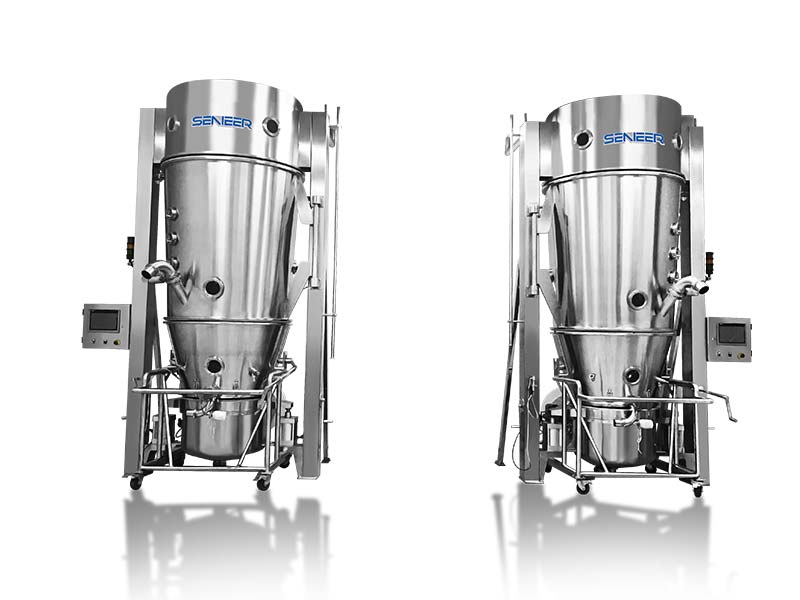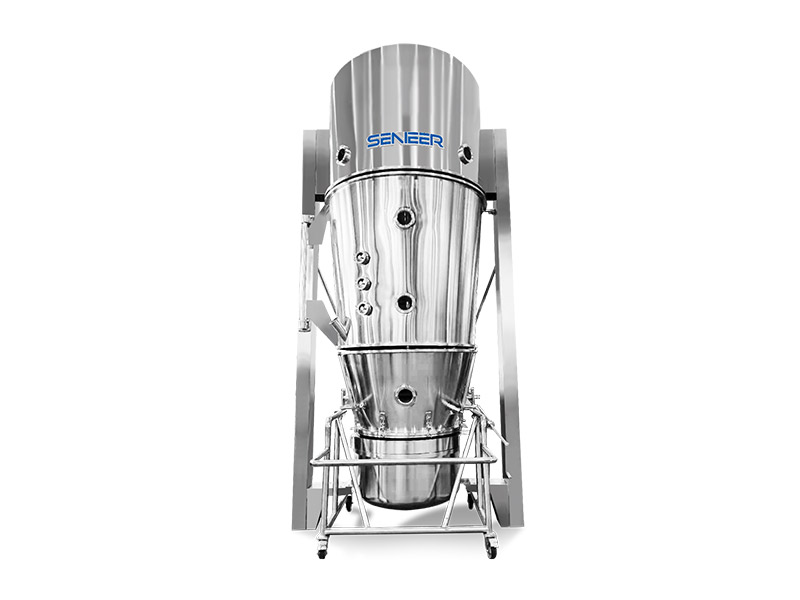Key Points Of This Chapter
Fluidization behavior is the sum of various interactions and inter-granule forces. To have good fluidization, a fluidized bed must maintain a good and effective fluidization speed. If it is too small, it cannot be fluidized; if it is too large, it will be transported by pneumatic force. Powder escapes and blocks the collection bag.
Understanding the material properties means in-depth understanding of the Geldart classification basis and powder characteristics, which provides theoretical support for establishing good fluidization process parameters.
The type of fluidized bed depends on the fluidization speed, product density, shape and weight of the product in the pot, as well as the structure of the air flow distributor. A process may be a comprehensive expression of one or several flow patterns, because the flow Dynamicization is a dynamic process.
This chapter mentioned air flow distributors many times. Later chapters will focus on introducing that the development of fluidized beds, especially the development of pharmaceutical fluidized beds, is actually closely related to the evolution of air flow distributors.

Fluidization Theory
Fluidized beds are characterized by rapid granule motion caused by rising airflow; therefore, good granule mixing, efficient mass and heat transfer, and uniform temperature distribution are achieved.
1.How Does Fluidization Occur?
The working principle of a fluidized bed is based on the theoretical basis that if gas is allowed to flow through a bed of granular solids at a velocity greater than the granule settling velocity and less than the pneumatic conveying and equal to the minimum fluidization velocity (Umf), the solid portion will be suspended in the upward movement The gas flow exerts a resistance high enough to overcome the downward force of gravity. Resistance is the friction force exerted by the gas on the granules; the resistance exerted by the granules on the gas is equal in magnitude and opposite in direction.
As the air flow rate increases, the viscous resistance of individual granules in the packed bed increases, resulting in an increase in bed pressure drop (ΔP). Up to a certain point, the drag force experienced by the individual granules is equal to their apparent weight; then the volume of the bed begins to expand. Individual granules are no longer in contact with neighboring granules but are supported by the fluid, and fluidization begins. For very viscous powders, the primary granules may be bound by van der Waals forces and may fluidize into agglomerated granules.
So when a granule becomes more fluidized, it affects the local gas velocity around it due to these drag forces. For granules with irregular shapes, the effect of drag is more significant. Above the minimum fluidization velocity, any additional gas introduced should pass through the bed in the form of bubbles. Van der Waals forces play a dominant role in powder handling and fluidization processes, but electrostatic forces also have a strong influence on the behavior of the process. Other potential forces are liquid and solid bridges. Possible interactions with intergranule forces are granule-granule, granule-chamber and granule-gas interactions. Two methods, the minimum fluidization velocity Umf and the Geldart classification, are generally recognized for their ability to predict and characterize the fluidization behavior of solids.
2.Type Of Fluidized Bed
In fluidized beds, different fluidized bed patterns can be observed, depending on the fluidization speed, product density, shape and weight of the product in the pot. Density directly changes the net gravitational force acting on the granule, and therefore the minimum resistance or speed required to lift the granule. Shape not only changes the relationship between drag force and velocity, but also changes the filling characteristics of the fixed bed and the associated void spaces and fluid velocities through them.
The calculated gas velocity (Umf) over the entire bed cross-section is called the minimum or incipient fluidization velocity. During initial fluidization, the bed assumes a liquid form and is self-balanced, flowing and transmitting hydrostatic forces (lower density objects float on the bed surface). At low gas velocities, the granule bed is actually a packed bed and the pressure drop is proportional to the surface velocity. As the gas velocity increases, a point is reached where the behavior of the bed changes from fixed granules to suspended granules. At the initial point of fluidization, the pressure drop across the bed will be very close to the weight of the granules divided by the cross-sectional area of the bed. During the initial fluidization process, the granules are very close together and have no real movement; in order to achieve uniform mixing, vigorous mixing needs to be achieved by increasing the gas velocity through different gas flow distributors.
When the gas flow rate exceeds the minimum fluidization point, the fluidized bed looks much like the gas rises rapidly and bursts at the surface. The formation of bubbles is very close to the bottom of the bed and very close to the air flow distributor, so the design of the air flow distributor has a great impact on the characteristics of the fluidized bed. Increasing the surface fluidization velocity above the minimum fluidization velocity results in the formation of “bubbles” that rise in the bed. Bed expansion is mainly caused by the space occupied by bubbles, and the surface gas velocity increases significantly. As these little bubbles rise from the bed, they tend to coalesce together. This creates larger and fewer bubbles than those near the airflow distributor. In a bubbling bed, mixing is caused not only by the vertical movement and collapse of bubbles on the bed surface, but also by the lateral movement of bubbles caused by the interaction and merger of adjacent bubbles.
- When the solids concentration throughout the bed is not uniform and the concentration fluctuates over time, this type of fluidization is called aggregate fluidization.
- A slug bed is a fluid bed in which air bubbles occupy the entire cross-section of the product container and divide the bed into several layers.
- An ebullating bed is a fluid bed in which bubbles are approximately the same size as the solid granules.
- A channeled bed is a fluid bed in which gases form channels in the bed through which most of the air passes.
- A spouted bed is a fluid bed in which the gas creates a single opening through which some granules flow and fall outside.
As the gas flow rate further increases, the bed continues to expand, the bed height increases, and the granule concentration per unit volume of the bed decreases. At a certain velocity of the fluidizing medium, known as the entrainment velocity, the granules are carried away by the gas. This phenomenon is called entrainment.
3.Control Air Flow Speed
Control of air flow rates is critical to efficient fluidized beds for drying, granulating, and coating. Only when the granules are suspended in the air flow during the treatment process can the fluidized bed achieve the advantages of rapid heat and mass transfer. In order to obtain proper fluidization of the product, the following factors must be considered:
01.Product weight (lot size).
02.granulesize, shape and density.
03.Powder flow characteristics.
04.The relationship between the capacity of the fluidized bed and the air volume and position of the fan and the position of the fluidization unit.
05.Minimum and maximum recommended capacity of the pot.

The control of air flow speed can first be achieved through the selected air flow distributor. The choice of distributor depends on factors such as the type of material and its granule size, density, shape, quantity, fan air volume and the location of the system. Distributor selection and further instructions are provided in Chapter 3. The type and geometry of the distributor have a significant impact on the minimum fluidization velocity value. Increasing the pore diameter of the orifice plate distributor will reduce the minimum fluidization velocity (voiceover: I wonder if you can understand this sentence?? The premise is that when the air volume remains unchanged, the ventilation distributor area of the same size increases the orifice plate aperture, which is equivalent to increasing the ventilation area, so the speed decreases).
4.Addressing Streaming Challenges
01 Determination Of minimum Fluidization Velocity And Bed Expansion
1).Note the weight of the load and its granulesize distribution.
2).Supply a low flow rate (lowest measured value) of feed process air to the bed and note the flow rate. Also pay attention to the height of the bed.
3).Increase the gas flow slightly and pay attention to the flow rate, pressure drop and bed height again.
4).Repeat step c until maximum flow rate is reached. Look at the top and sides of the bed and note the flow rate when the bed is first fluidized (granules start to vibrate).
5).Repeat step c, starting with a high flow rate and gradually decreasing the flow rate slightly. Note the flow rate when the bed is first drained.
02 If Erratic Fluidization Or No Fluidization Of The Product Is Observed Possible Causes
1).Differences in granulesize and density create differences in velocity between lighter granules and denser granules. Uniform fluidization can be produced by selecting similar granulesizes and densities.
2).The product amount is too small, the fluidization speed and/or the air volume is too high.
3).The air distributor may not be suitable for providing high velocities to the incoming air. Replacing the air distributor with a more open air distributor will provide higher velocities and may help fluidize the product.
4).If streaming is not occurring at all, this could be for several reasons, such as:
- The mass of product in the container is greater than the capacity of the container and the blower (fan).
- Or the product density may be too high.
- The airflow distributor could be more open, the fluidization velocity is not high enough. Increasing the air intake will provide the kinetic energy needed to fluidize the batch.
- In extreme cases, as with most sticky powders or wet granular products, or materials such as centrifuge cakes being dried, some fluidized bed unit manufacturers provide mechanical rakes at the bottom of the pot or lower plenum to facilitate breakup of the clumps, thus Helps flow.
- granules smaller than 50 μm are difficult to fluidize due to their viscosity. These are granules belonging to Group C in the Geldart powder classification. Due to the high surface to volume ratio between granules, these granules tend to form agglomerates of random size and shape. This strong interaction between powders affects fluidization. In this case, a mechanical rake can help change the hydrodynamic behavior of the powder and aid in fluidization. (Voiceover: But this is not absolute. With the development of fluidized bed technology, there are already fluidized beds specifically designed for fluidized granulation and coating of micron-sized powders. Interested enthusiasts can refer to: How to achieve true powder coating?)
- The flow rate corresponding to the maximum bed pressure drop increases as the opening rate of the air distributor increases.
- During the drying process, uneven fluidization can be noticed due to the short drying time and low pressure drop across the bed.
5).Determine The Fluidization Volume That Best Suits Process Considerations:
- For example, for fluidized bed granulation, the flow pattern of the powder should be like a fountain or free downward flow, so that the upward-moving granules get atomized droplets of the binder solution. Fluidization levels above optimal will produce powders that can entrain and clog the filter.
- Exhaust temperature can be used to detect poor fluidization. A rapid increase in exhaust air temperature may indicate improper fluidization.
5.Summary
Fluidization in fluidized bed processes is critical to achieving uniform mixing of granules. Whether granulating, drying or coating, an appropriate level of fluidization is required within the processor. Uneven fluidization can lead to changes in moisture content, granule size distribution, or unpelletized product, resulting in poor content uniformity. Establishing a minimum fluidization velocity and controlling the bed by observing the pressure drop across the bed and filter will provide better control of the process.